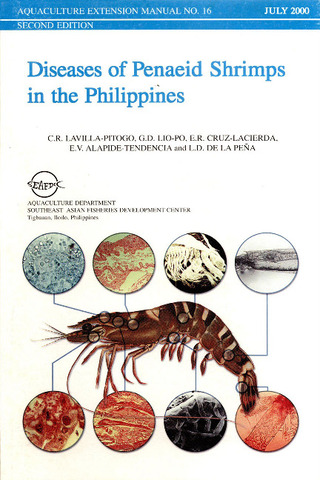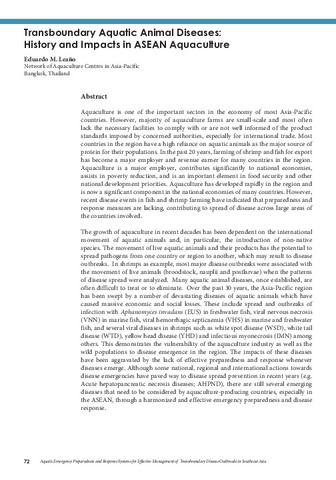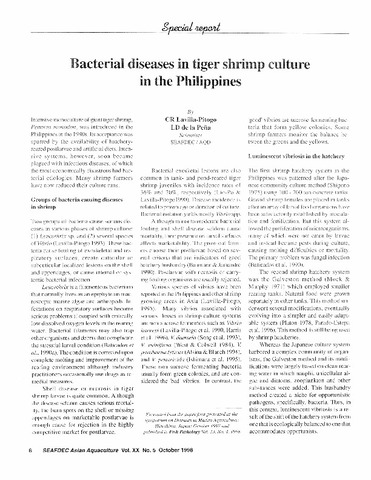| dc.contributor.author | Lazarte, Jassy Mary S. | |
| dc.contributor.author | Maningas, Mary Beth B. | |
| dc.contributor.editor | Romana-Eguia, Maria Rowena R. | |
| dc.contributor.editor | Parado-Estepa, Fe D. | |
| dc.contributor.editor | Salayo, Nerissa D. | |
| dc.contributor.editor | Lebata-Ramos, Ma. Junemie Hazel | |
| dc.date.accessioned | 2016-01-20T07:40:21Z | |
| dc.date.available | 2016-01-20T07:40:21Z | |
| dc.date.issued | 2015 | |
| dc.identifier.citation | Lazarte, J. M. S., &Maningas, M. B. B. (2015). Targeting essential gene utilizing RNA interference to protect the ailing shrimp/prawn industry against WSSV. In M. R. R. Romana-Eguia, F. D. Parado-Estepa, N. D. Salayo, &M. J. H. Lebata-Ramos (Eds.), Resource Enhancement and Sustainable Aquaculture Practices in Southeast Asia: Challenges in Responsible Production of Aquatic Species: Proceedings of the International Workshop on Resource Enhancement and Sustainable Aquaculture Practices in Southeast Asia 2014 (RESA) (pp. 283-298). Tigbauan, Iloilo, Philippines: Aquaculture Department, Southeast Asian Fisheries Development Center. | en |
| dc.identifier.isbn | 9789719931041 | |
| dc.identifier.uri | http://hdl.handle.net/10862/2783 | |
| dc.description.abstract | The white spot syndrome virus (WSSV) remains to be the most widespread and devastating infectious agent that has hit particularly the marine shrimp aquaculture industry worldwide. To date, there are no known effective strategies that can combat WSSV infection. This study aimed to elucidate host-pathogen interaction through the functional study of host - gene. Utilizing RNA Interference, the function of contig23 (c23) in the shrimp genome, identified to have high homology with WSSVORF-325, was determined. Three set-ups were prepared for treatment of c23-, GFP-dsRNA, and PBS using Macrobrachium rosenbergii freshwater prawns. Each treatment group was challenged with WSSV and survival rate was recorded. C23-, and GFP-dsRNA injected prawns showed a significant survival rate of 100%, in contrast to 20% of the PBS injected prawns at 10 days post-infection (dpi). Results showed that injection of c23- and GFP-dsRNA prior to challenge with WSSV, delayed and reduced mortality in contrast to PBS-treated prawns, which showed high mortality. Gene expression analysis showed silencing of both WSSV and c23 at day 3 post-WSSV challenge. This study proved that c23-dsRNA has a protective effect on WSSVchallenged prawns and highlights its involvement in the infectivity of WSSV in M. rosenbergii. | en |
| dc.language.iso | en | en |
| dc.publisher | Aquaculture Department, Southeast Asian Fisheries Development Center | en |
| dc.subject | Macrobrachium rosenbergii | |
| dc.subject | WSSV | en |
| dc.subject | Host-pathogen infection | en |
| dc.subject | Shrimp genome | en |
| dc.subject | Gene expression analysis | en |
| dc.title | Targeting essential gene utilizing RNA interference to protect the ailing shrimp/prawn industry against WSSV | en |
| dc.type | Conference paper | en |
| dc.citation.spage | 283 | |
| dc.citation.epage | 298 | |
| dc.subject.asfa | genomes | en |
| dc.subject.asfa | mortality | en |
| dc.subject.asfa | viral diseases | en |
| dc.subject.asfa | shrimp culture | en |
| dc.subject.asfa | RNA | en |
| dc.subject.asfa | fish diseases | en |
| dc.subject.asfa | husbandry diseases | en |
| dc.subject.asfa | disease prophylaxis | en |
| dc.subject.asfa | survival | en |
| dc.subject.asfa | prawn culture | en |
| dc.subject.asfa | pathogens | en |
| dc.citation.conferenceTitle | Resource Enhancement and Sustainable Aquaculture Practices in Southeast Asia: Challenges in Responsible Production of Aquatic Species: Proceedings of the International Workshop on Resource Enhancement and Sustainable Aquaculture Practices in Southeast Asia 2014 (RESA) | en |



